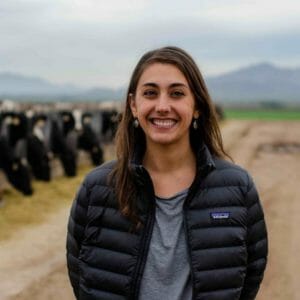
In this series, we’re meeting with Swette Center team members to explore their background in food systems, what they are currently working on, and their vision of food systems transformation.
Read on for an interview with Carly Wyman, Senior Research Specialist.
When did you first get interested in food systems work?
I first became interested in food systems when I was in college as an undergrad studying international affairs. Through that, I got interested in international development and I ended up writing my undergraduate thesis on agricultural distress in India. I studied poor rural farmers and how a combination of factors led to a crisis among them where they were committing suicide at really high rates. Essentially, for the farmers, it was a combination of environmental stress such as drought and access to capital. These two stressors were causing farmers to feel like they could no longer go on. That’s when I first became interested in agriculture and agriculture policy. I realized that simply getting people the support they need to meet their basic needs is at the root of a lot of international development issues. From there I went on to become a WWOOFer which is what brought me to Hawai’i, where I am now. That was 8 years ago when I started working on farms to learn skills to grow my own food. Then that eventually led me to the Swette Center. I completed the food policy and sustainability leadership certificate and then I did the full masters this past year.
What are you working on currently?
I am currently wrapping up a project that I’ve spent the past 6 months working on, which is a feasibility study on industrial juicing equipment for Hawai’i island. There is a weakness in the Hawaii food chain which is due to our lack of a mid-tier value chain. This is a system where we have farmers and the markets for food, but the whole infrastructure is lacking processing aggregation and packaging distribution. This is partly why Hawai’i relies so heavily on imported food. It’s also very expensive to do anything there because they’re so remote. Hawai’i doesn’t have the same access to resources and industry that they have on the mainland. So, I am working on looking at the feasibility of establishing juicing equipment as a farmer-owned cooperative. This would be mostly fruit farmers because that is the equipment that exists. It used to produce thousands of gallons of juice in the past and it utilizes local fruits. We’re finishing up the study and we are finding that there is not enough fruit being produced locally to justify using a system of this scale. A big lesson is that we need to increase fruit production in the islands. We also found that there’s a lot of interest in seeing a project like this become a business. Additionally, farmers are interested in a cooperative model to build local markets for their products. It’s an identified need to tap our processing infrastructure but there are other pieces in the chain that need to be created first, such as increasing production.
Then the other project that’s just ramping up is aquaculture production in Hawai’i. I’m looking into both traditional and native Hawaiian aquaculture systems, as well as modern aquaculture systems. I’m trying to identify the potential of farm-raised fish as a sustainable seafood option for Hawai’i. People in Hawai’i eat a lot of fish and surprisingly still import a lot of fish. There is some stigma among Hawai’i consumers against both fresh-water fish and farmed fish.. I am hoping to contribute to changing consumer preferences and build additional markets for more sustainable fish options.
What do you think is a priority in transforming food systems?
The political clout of small farmers, in particular, needs to be built up. There’s a lot of will from the residents and farmers to improve the food system in Hawai’i, but there’s not the political will. Our policies and the state budgets for the department of agriculture in Hawai’i receive less than 2 percent of the overall state budget. They’re not able to implement as much as they need to increase food security overall.
Another priority is actually supporting our local and small farmers. Lastly, overall for the US, we must start prioritizing regenerative agriculture. We need agriculture that’s not harmful to the land in order to be sustainable in feeding ourselves long-term.
Any advice for current food systems students?
I recommend doing WWOOF and going to work with farmers. I think that it’s incredibly important for anybody wanting to do food systems work to get hands-on experience growing food. It’s also important to make connections with your local farmers. When I did the food policy and sustainability leadership program, the Swette team took us to meet a lot of farmers around Arizona and it was a very valuable experience. If you’re working on a more systemic level, you need to be familiar with the actual issues that farmers face.
What is your favorite food to make?
My community and I recently made an underground oven in a traditional land-cooking style called Imu in Hawaiian. I know that Native Americans across the U.S. do similar things. We dug a hole to cook our food overnight underground. We cooked wild pork (there’s a lot of wild pigs here) and some starchy root vegetables like taro, and breadfruit to top it off. It’s a lot of work to do the whole Imu process, but I love connecting with traditional ways of making food and using foods that are grown right here on this land. It’s very much a community-focused activity. It takes the efforts of a lot of people to chop the wood, heat the rocks, collect the banana leaves, and many other things. The food just tastes so good when you put all that work into it.